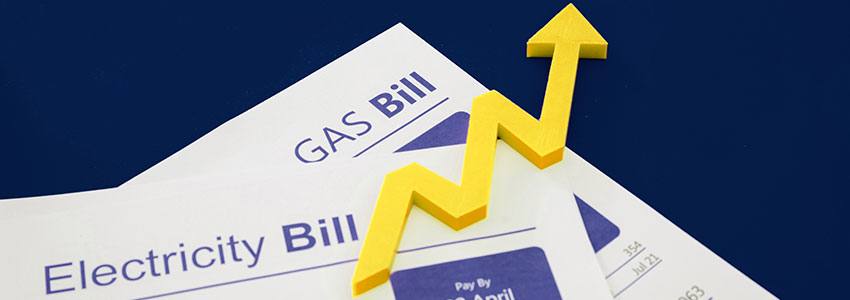Tips For Agile Businesses In The Face Of Skyrocketing Costs and Potential Blackouts
The energy crisis in the UK is a perfect storm of circumstances. The COVID-19 pandemic created pressures around supply and demand, with wholesale gas and power prices reaching historic highs and at least 25 utilities suppliers going bankrupt. The Russian invasion of Ukraine and the ensuing restriction on gas exports has exacerbated the problem, with the price of natural gas soaring to five times what it was a year ago. There are also concerns about ‘energy nationalism’ if European nations restrict exports owing to shortages – particularly as winter sets in.
What does this mean for businesses? The immediate effect is continuing radical price hikes, with rumblings of emergency plans, energy rations, and tariff increases for heavy users in industry put forward as part of an emergency plan. With traders experiencing a 424% rise in gas and 349% increase in electricity costs since February 2021, the future feels uncertain for many business owners.
CHANGE WITH THE TIMES FOR A BRIGHT FUTURE
The current system may seem untenable for many businesses – especially as winter approaches and so demand increases. However, changing times demand a change in approach. Working on an energy strategy alongside a reliable facilities maintenance provider could hold the key to continuity during this tumultuous time in history – and serves to futureproof operations into the long term.
Your first defence against the sharp rise in energy costs is to reduce consumption. On an individual level, this has a direct bearing on billing and profitability – a 10% reduction in usage for the average medium-sized business could save up to about £700 per year. Collectively, this has been put forward as the primary way to ease demand on the grid and reduce market prices. This can be achieved at various touchpoints within your building and organisation.
With prices on the rise, there is little room for trial and error. Businesses should formulate strategic partnerships with facilities maintenance companies and technology providers in order to fast track energy efficiency measures with the best possible margin for success. Increased energy efficiency doesn’t need to be resource-intensive for your business. These partners provide clear and attainable roadmaps to streamline businesses for reduced interruptions; cost savings; and improved performance, profitability, and resilience.
THE STEPS TO ENERGY SAVINGS
Identify Potential Savings
Do you know the most energy intensive parts of your business? Many businesses cannot account for the energy consumption of their operations. The first step in any energy efficiency plan is to request a review of your site around consumption. This energy audit by a reliable facilities maintenance company will give you and your partners a clear view on the breakdown of your usage and create a clear picture for reduced usage and minimal disruption to operations.
Work on an Energy Efficiency Strategy
The site review creates clearly defined focus points for a comprehensive energy efficiency strategy. This guides facilities maintenance professionals in determining a short-, medium-, and long-term energy efficiency strategy. This includes:
- Identifying the most energy intensive equipment within an enterprise.
- Identifying the times at which this equipment is used and whether this can be optimised for billing purposes.
- Identifying equipment that is drawing more than optimal electricity and making recommendations for rectifying this.
- ‘Invisible’ drains on electricity such as night lighting, etc.
- Issues with building management systems that impact energy usage.
- Benchmarking against industry trends.
- How to achieve evidenced savings over time.
The energy efficiency strategy includes:
- Sourcing and negotiating the best rates and avoiding default tariffs.
- Ongoing energy monitoring through metering and sub-metering.
- Bill validation to ensure no overcharging.
- The use of technology in achieving energy efficiency monitoring and goals.
- Your building’s structure and insulation – and their effect on efficiencies.
- Renewable energy sources.
- Building management and maintenance best practices for energy efficiency.
Make The Move To Renewables
The UK and European reliance on gas is one of the core issues of this energy crisis. While a move to coal and other energy sources has been put forward as one of the myriad solutions, renewable energy sources are environmentally conscientious and forward-facing. If renewables are the future, making the gradual shift towards these energy sources should be in the arsenal of every business owner contemplating operations in the future. Facilities maintenance specialists provide blueprints for the evolution of systems towards green alternatives.
Evaluate Your Equipment
Your machinery can be your business’s biggest asset, but it can also drain unnecessary energy. In many cases, legacy systems don’t offer energy efficiency features of newer models. Similarly, where maintenance has been delayed or overlooked, this can have a bearing on efficiency.
From initial installation to the succession of systems, it makes sound business sense to discuss equipment with facilities maintenance professionals. These individuals often have their finger on the pulse on the latest industry trends and developments and are able to advise on the best equipment to suit your business needs.
Easy Gains Through Maintenance and Robust BMS
Energy efficiency encompasses a broad range of considerations. From light sensors and energy-saving bulbs to HVAC and boiler systems and insulation, FM practitioners can get you started on quick and easy changes with a direct effect on efficiencies. Additionally, devising a consistent schedule of preventative maintenance interventions, as well as a reactive maintenance plan, is an investment in the viability and efficiency of your critical equipment.
Use Technology To Get Started And To Map Progress
Metering and sub-metering are one of the top ways to monitor energy usage and, these days, metering systems are a given in the commercial built environment. There have been additional, exciting technological advancements with a direct impact on energy efficiency in the realm of the Internet of Things (IoT) – like those available from IQ Insight in partnership with Voltix Services.
These smart technologies use a system of tags and sensors to collect continuous data from your business with detailed insights on energy usage. This data is conveyed and stored on a cloud-based, remotely accessible dashboard. This has impressive possibilities including alerts around spikes in energy consumption, real-time monitoring, accurate reporting and evidenced outcomes, and digital record-keeping. This is the most powerful energy monitoring tool for single-site and small businesses and large, multi-site operations in equal measure.
Benefits include:
Temperature monitoring – Heating and cooling can account for energy wastage. Smart technologies allow you to set thresholds around optimal occupant comfort, unoccupied zones, and peak energy demand timings. It also serves as an early alert system for faults and excessive use. Smart technologies can also inform and affect contributing factors, such as ventilation, automated window shading
Occupancy sensors – Energy being used in unoccupied spaces is energy wasted. Think about constantly lit corridors or warehouses, nighttime and weekend standby power and lighting. By collecting this data over time, business owners are also able to assess and analyse occupancy trends to optimise space usage with energy in mind.
Data-inspired strategy and overall building management – One of the main benefits of smart technologies is that the assimilation of data means less is left to chance when it comes to strategic decision-making. The collection of real-time data has potential to inspire instant action when events, behaviour, or metrics fall outside predefined thresholds. Using smart technologies, data leaves no stone unturned, giving strategic decision-makers clear insights on what is happening in a business. This helps to accurately identify areas of change, gauge ROI and project success, and actively monitor operations for more effective day-to-day management.
Monitoring Machinery – Your equipment is your greatest asset. Smart sensors and technologies allow for impressive monitoring opportunities to ensure optimised outputs and efficient running, as well as quick identification of faults. Metrics around these machines could include everything from temperature to changes in atmospheric conditions, vibration and sound for worker wellbeing, and hours of operation to guide perfected maintenance schedules.
Energy Measurement – Current meters are used to accurately measure energy consumption in real time. They are also a core tool for digital transformation to automated and AI processes – for example, around peak usage, plug load, and lighting.
CAN YOU AFFORD NOT TO START ENERGY SAVING?
Rising energy costs affect everything. Our cost of living is increasing, as is the cost of doing business. Faced with challenges on all fronts, establishing meaningful strategic partnerships with FM and technology companies means to mitigate costs and maintain profitability.
The team at Voltix Services has the experience, expertise, technology, and tools to advise businesses on a new age of energy efficiencies. Combining maintenance and comprehensive BMS services with a leading IoT offering, the future is bright with Voltix Services and IQ Insight. Contact Voltix Services for more information on their energy services today.

